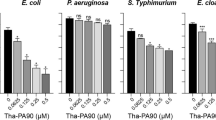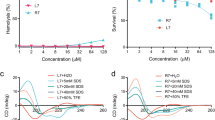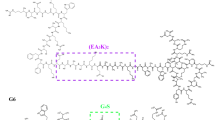Abstract
The antimicrobial peptides, such as host immune system-derived human bactericidal/permeability-increasing protein (hBPI), are the potential drugs for antibiotic-resistant Gram-negative bacterial infection. However, whether the purified chimeric hBPI23-Fcγ protein has bactericidal activity against drug-resistant Gram-negative bacteria (GNB) and the relevant mechanisms have not been fully elucidated. In this study, the chimeric hBPI23-Fcγ protein, which consisting of the functional N terminus of BPI and Fcγ1, were expressed and purified in a lab-scale. The chimeric hBPI23-Fcγ protein showed longer half-life up to 148.2 min in vivo. The hBPI23-Fcγ protein also showed significant bactericidal activity against standard and clinically isolated drug-resistant Acinetobacter baumannii (A. baumannii) and Escherichia coli (E. coli). In addition, the hBPI23-Fcγ protein markedly decreased biofilm formation, neutralized bacterial lipopolysaccharides (endotoxin) and enhanced the opsonization of phagocytes, as well as significantly improved the survival rate of minimal lethal dose (MLD) of drug-resistant E. coli -infected mice. These results indicate that the BPI23-Fcγ protein protected mice from drug-resistant GNB infection not only by direct bactericidal effect, but also by promoting opsonophagocytosis of macrophages. In conclusion, the chimeric BPI23-Fcγ protein may be as a promising candidate of non-antibiotic biological agent for drug-resistant GNB infection.
Graphical Abstract







Similar content being viewed by others
Data availability
No datasets were generated or analysed during the current study.
References
P E, J W (1993) The bactericidal/permeability-increasing protein (BPI), a potent element in host-defense against gram-negative bacteria and lipopolysaccharide. Immunobiology 187 https://doi.org/10.1016/s0171-2985(11)80354-2
Alexander S, Bramson J, Foley R, Xing Z (2004) Protection from endotoxemia by adenoviral-mediated gene transfer of human bactericidal/permeability-increasing protein. Blood 103:93–99
Almudena B, Patricia M, Emilio B (2019) Risk stratification for multidrug-resistant Gram-negative infections in ICU patients. Curr Opin Infect Dis 32. https://doi.org/10.1097/qco.0000000000000599
Baldo BA (2015) Chimeric fusion proteins used for therapy: indications, mechanisms, and safety. Drug Saf 38:455–479. https://doi.org/10.1007/s40264-015-0285-9
Batoni G, Maisetta G, Esin S (2016) Antimicrobial peptides and their interaction with biofilms of medically relevant bacteria. Biochim Biophys Acta 1858:1044–1060. https://doi.org/10.1016/j.bbamem.2015.10.013
Bauer RJ et al (1996) A phase I safety and Pharmacokinetic study of a Recombinant amino terminal fragment of bactericidal/permeability-increasing protein in healthy male volunteers. Shock (Augusta Ga) 5:91–96
Berg MJ, Lantz RK, Schoenwald RD, Clarke MI, Schottelius DD (1983) Optimization of Pharmacokinetic monitoring: I. Linear Pharmacokinetics. Ther Drug Monit 5:379–387
Bersier LF, Sugihara G (1997) Scaling regions for food web properties. Proc Natl Acad Sci USA 94:1247–1251
Chen J et al (2007) Protection of mice from lethal Escherichia coli infection by chimeric human bactericidal/permeability-increasing protein and Immunoglobulin G1 Fc gene delivery. Antimicrob Agents Chemother 51:724–731
Chen F et al (2017) Bactericidal Permeability-Increasing proteins shape Host-Microbe interactions. MBio 8. https://doi.org/10.1128/mBio.00040-17
De Oliveira DMP et al (2020) Antimicrobial resistance in ESKAPE pathogens. Clin Microbiol Rev 33. https://doi.org/10.1128/CMR.00181-19
J W et al. (1992) Human bactericidal/permeability-increasing protein and a Recombinant NH2-terminal fragment cause killing of serum-resistant gram-negative bacteria in whole blood and inhibit tumor necrosis factor release induced by the bacteria. J Clin Invest 90 https://doi.org/10.1172/jci115930
Fernandes P, Martens E (2017) Antibiotics in late clinical development. Biochem Pharmacol 133:152–163. https://doi.org/10.1016/j.bcp.2016.09.025
Fisher CJ, Marra MN, Palardy JE, Marchbanks CR, Scott RW, Opal SM (1994) Human neutrophil bactericidal/permeability-increasing protein reduces mortality rate from endotoxin challenge: a placebo-controlled study. Crit Care Med 22:553–558
Giroir BP, Scannon PJ, Levin M (2001) Bactericidal/permeability-increasing protein–lessons learned from the phase III, randomized, clinical trial of rBPI21 for adjunctive treatment of children with severe meningococcemia. Crit Care Med 29:S130–S135
Hasan CM, Dutta D, Nguyen ANT (2021) Revisiting antibiotic resistance: mechanistic foundations to evolutionary outlook. Antibiot (Basel Switzerland) 11. https://doi.org/10.3390/antibiotics11010040
Hoffman PS (2020) Antibacterial discovery: 21st century challenges. Antibiot (Basel Switzerland) 9. https://doi.org/10.3390/antibiotics9050213
Hou X et al (2020) Vitamin lipid nanoparticles enable adoptive macrophage transfer for the treatment of multidrug-resistant bacterial sepsis. Nat Nanotechnol 15:41–46. https://doi.org/10.1038/s41565-019-0600-1
I JWPE O, H O (1978) Purification and characterization of a potent bactericidal and membrane active protein from the granules of human polymorphonuclear leukocytes. J Biol Chem 253
Iovine NM, Elsbach P, Weiss J (1997) An opsonic function of the neutrophil bactericidal/permeability-increasing protein depends on both its N- and C-terminal domains. Proc Natl Acad Sci USA 94:10973–10978
Jomkuan T, Sladjana S-G, Ashley SB, Rachel MW, William FCR (2021) Bactericidal/Permeability-Increasing protein preeminently mediates clearance of Pseudomonas aeruginosa in vivo via CD18-Dependent phagocytosis. Front Immunol 12. https://doi.org/10.3389/fimmu.2021.659523
Kong Q et al (2012) Infecting mice with Recombinant Ad5-BPI₂₃-Fcγ1 virus protects against systemic Escherichia coli challenge. J Med Microbiol 61:1262–1269. https://doi.org/10.1099/jmm.0.040907-0
Kostakioti M, Hadjifrangiskou M, Hultgren SJ (2013) Bacterial biofilms: development, dispersal, and therapeutic strategies in the dawn of the postantibiotic era. Cold Spring Harbor Perspect Med 3:a010306. https://doi.org/10.1101/cshperspect.a010306
Lagassé HAD, Hengel H, Golding B, Sauna ZE (2019) Fc-Fusion drugs have FcγR/C1q binding and signaling properties that May affect their immunogenicity. AAPS J 21:62. https://doi.org/10.1208/s12248-019-0336-8
Lazzaro BP, Zasloff M, Rolff J (2020) Antimicrobial peptides: application informed by evolution. Sci (New York N Y) 368. https://doi.org/10.1126/science.aau5480
Levin M et al (2000) Recombinant bactericidal/permeability-increasing protein (rBPI21) as adjunctive treatment for children with severe meningococcal sepsis: a randomised trial. rBPI21 meningococcal sepsis study group. Lancet (London England) 356:961–967
Li C et al (2006) Protection of mice from lethal endotoxemia by chimeric human BPI-Fcgamma1 gene delivery. Cell Mol Immunol 3:221–225
Li J et al (2008) Protection of immuno-compromised mice from lethal infection of Klebsiella pneumonia by rAAV2-BPI23-Fcgamma1 gene transfer. Cell Mol Immunol 5:439–445. https://doi.org/10.1038/cmi.2008.55
Li D, Kumari B, Makabenta JM, Gupta A, Rotello V (2019) Effective detection of bacteria using metal nanoclusters. Nanoscale 11:22172–22181. https://doi.org/10.1039/c9nr08510f
Li Z et al (2020) Antibacterial fusion protein BPI21/LL-37 modification enhances the therapeutic efficacy of hUC-MSCs in sepsis. Mol Therapy: J Am Soc Gene Therapy 28:1806–1817. https://doi.org/10.1016/j.ymthe.2020.05.014
Luong HX, Thanh TT, Tran TH (2020) Antimicrobial peptides - Advances in development of therapeutic applications. Life Sci 260:118407. https://doi.org/10.1016/j.lfs.2020.118407
Lv Z et al (2016) Long-term anti-endotoxin/E. Coli efficacy in mice transfected with AAV2/1-muBPI25 -muFcγ1. APMIS: Acta Pathologica Microbiol Et Immunol Scand 124:888–895. https://doi.org/10.1111/apm.12582
Mba IE, Nweze EI (2022) Antimicrobial peptides therapy: an emerging alternative for treating Drug-Resistant bacteria. Yale J Biol Med 95:445–463
Organization WH (2014) ZH mediacentre news 2014: WHO’s first global report on antibiotic resistance reveals serious, worldwide threat to public health. World Health Organization
Qingli K, Zhe L, Yun K, Yunqing A, Zhenlong L, Jianmin Z (2021) Bactericidal permeability increasing protein deficiency aggravates acute colitis in mice by increasing the serum levels of lipopolysaccharide. Front Immunol 11. https://doi.org/10.3389/fimmu.2020.614169
Ruckert A et al (2020) Governing antimicrobial resistance: a narrative review of global governance mechanisms. J Public Health Policy 41:515–528. https://doi.org/10.1057/s41271-020-00248-9
Shrivastava SRL, Shrivastava PS, Ramasamy J (2018) World health organization releases global priority list of antibiotic-resistant bacteria to guide research, discovery, and development of new antibiotics. J Med Soc 32:76
Sommer MOA, Munck C, Toft-Kehler RV, Andersson DI (2017) Prediction of antibiotic resistance: time for a new preclinical paradigm? Nat Rev Microbiol 15:689–696. https://doi.org/10.1038/nrmicro.2017.75
Theprungsirikul J, Skopelja-Gardner S, Rigby WFC (2021) Killing three birds with one BPI: bactericidal, Opsonic, and anti-inflammatory functions. J Translational Autoimmun 4:100105. https://doi.org/10.1016/j.jtauto.2021.100105
Wang Y et al (2024) BPI23-Fcγ alleviates lethal multi-drug-resistant acinetobacter baumannii infection by enhancing bactericidal activity and orchestrating neutrophil function. Int J Antimicrob Agents 63:107002. https://doi.org/10.1016/j.ijantimicag.2023.107002
Wiezer MJ et al (1998) Pharmacokinetics of a Recombinant amino terminal fragment of bactericidal/permeability increasing protein (rBPI21) after liver surgery in rats and humans. Shock (Augusta, Ga.) 10:161-6; discussion 167-8. https://doi.org/10.1097/00024382-199809000-00002
World Health Organization (2023) Antimicrobial resistance. Available from https://www.who.int/news-room/fact-sheets/detail/antimicrobial-resistance. Accessed Dec. 3, 2023
Acknowledgements
We thank all individuals who participated in this study.
Funding
This work was supported by Chinese Academy of Medical Sciences Innovation Fund for Medical Sciences (CIFMS 2021-I2M-1-048) and Medical Innovation Capacity Enhancement Special Program of Capital Medical University (CXZX 202308).
Author information
Authors and Affiliations
Contributions
The study was designed by QK, YA, and BC. Experiments were performed by TM, YW, CH, and QK. Results were analyzed by TM, XZ and QK. TM, XZ, YA and QK wrote the paper. All authors read and revised the paper. All authors contributed to the article and approved the submitted version.
Corresponding authors
Ethics declarations
Competing interests
The authors declare no competing interests.
Additional information
Communicated by Mehak Khan.
Publisher’s note
Springer Nature remains neutral with regard to jurisdictional claims in published maps and institutional affiliations.
Electronic supplementary material
Below is the link to the electronic supplementary material.
Rights and permissions
Springer Nature or its licensor (e.g. a society or other partner) holds exclusive rights to this article under a publishing agreement with the author(s) or other rightsholder(s); author self-archiving of the accepted manuscript version of this article is solely governed by the terms of such publishing agreement and applicable law.
About this article
Cite this article
Ma, T., Wang, Y., Huang, C. et al. Chimeric hBPI23-Fcγ protein shows bactericidal activity against drug-resistant Gram-negative bacteria and protects mice from lethal challenge. Arch Microbiol 207, 103 (2025). https://doi.org/10.1007/s00203-025-04306-2
Received:
Revised:
Accepted:
Published:
DOI: https://doi.org/10.1007/s00203-025-04306-2




